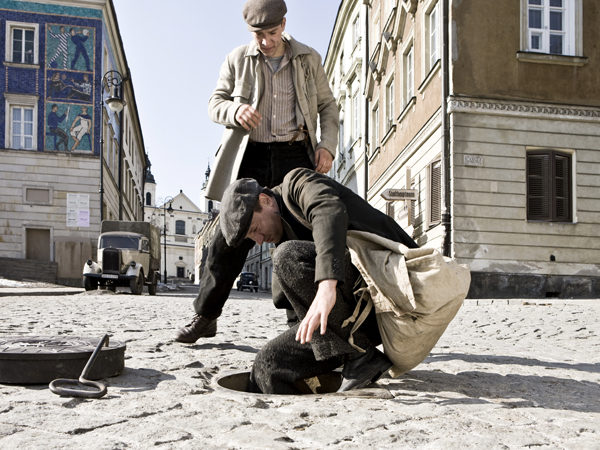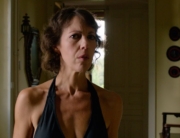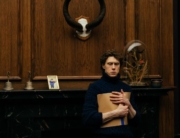
Krzysztof Skonieczny (standing) and Robert Wieckiewicz in IN DARKNESS (Jasmin Marla Dichant/Sony PIctures Classics)
![]() More than two decades ago, Polish director Agnieszka Holland brought to life the extraordinary biography of how one young Jewish man survived the Holocaust by hiding inside the heart of Nazi darkness in Europa Europa. With even more visual impact, In Darkness, a nominee for the Foreign-Language Film Academy Award, tells a harrowing true story of a group of Jews hidden underneath ghetto streets. But it also reveals the ordinary man who was their crucial pipeline to survival.
More than two decades ago, Polish director Agnieszka Holland brought to life the extraordinary biography of how one young Jewish man survived the Holocaust by hiding inside the heart of Nazi darkness in Europa Europa. With even more visual impact, In Darkness, a nominee for the Foreign-Language Film Academy Award, tells a harrowing true story of a group of Jews hidden underneath ghetto streets. But it also reveals the ordinary man who was their crucial pipeline to survival.
By the spring of 1943, Lvov, Poland (now Lviv in the Ukraine) had been buffeted between Soviet then German occupation. Ukrainian nationalists allied with the Nazis to control the city, first pushing a hundred thousand Jews into a restrictive ghetto, then forcing them into the factories of the Janowska slave labor camp, which became the deadly gateway to the Belzec extermination camp. Amidst attacks on Jews, Leopold Socha (Robert Wieckiewicz), who goes by the name Poldek, and his co-worker Stefek (Krzysztof Skonieczny) rummage around a nice apartment in the emptying ghetto and hide their stolen goods underneath a manhole cover where they work—in the sewers.
As Poldek enjoys a comfortable respite with his wife Wanda (Kinga Presis) and young daughter, Jews are negotiating to survive, like black marketer Mundek Margulies (Benno Fürmann), who trades goods for food (garnering the ghetto nickname of “Pirate”—it sounds like “Corsair” in Polish), while others search for escape routes, like a group digging through a basement to reach the sewer tunnels. When they break through, they are confronted by the sewer workers. There’s deep mistrust on both sides—until Poldek follows them back to the cellar and sees a mother and her two young children. He agrees to assist them—for a fee, even though a Ukrainian police officer, who he had been a snitch for in the past, now wants Poldek’s help to collect the bounties on any Jews found in underground.
In the horrible, brutal chaos of the final ghetto liquidation, more Jews try to frantically flee underground, where supplies and valuables fall out of reach. But they complain about the rats and dank conditions, and resent each other’s differences—including religious observance, class, and origins, let alone the crying toddler. With Holland’s insistence that the story be realistically told through many dialects, language and education become a point of contention and mockery. (Fürmann is such a major German actor that it took me a few minutes to realize he was playing a Polish Jew, until he talks of a long sojourn in Germany).
Poldek insists he can only sneak down supplies for the original group who have pooled their payments (subsidized mostly from the remnants of one family’s jewelry store). So a difficult decision has to be made of who will have to find shelter within the tunnels on their own. Even with this terrible dilemma in the face of relentless pursuers, some can’t face the awful conditions, others think they can follow other routes to safety, some prefer suicide, and many are killed at the exit points by guns and grenades. When they crawl to a temporary haven below a church, things change from bad to worse.
Over an astounding 14 months, portrayed with gripping tension, Poldek above ground and the group below deal with the constant threat of discovery due to the slightest slip; the ravages of disease, vermin, limited rations, seasonal floods (as vivid as Titanic in narrow tubes), planted mines; and ever more draconian choices amidst the ebb and flow of human interactions in the filthy confines. The cinematography is a staggering tour de force by director of photography Jolanta Dylewska, allowing the audience’s eyes to adjust and make out faces and actions in the flicker of feeble lanterns. We reel back at each glimpse of daylight.
In terms of style and theme, Holland very much follows in the footsteps of her mentor, Polish master Andrzej Wajda, who has also revisited the complexities of World War II several times. The vicious anti-Semitic Ukrainians are the Nazis’ henchmen and a working-class Polish nationalist is the hero, with the Soviet onslaught providing a tragic coda. Very little, amazingly, is fictionalized—a couple of participants conflated, insinuations made explicit, minor incidents ratcheted up for cinematic expression. Krystyna Chiger wrote about this experience from her childhood perspective in her 2008 memoir, The Girl in the Green Sweater: A Life in Holocaust’s Shadow (she’s portrayed in the film), while the thrilling In the Sewers of Lvov (1990), based on journals and interviews with the adult survivors who hid their story for decades from resurgent anti-Semitism, will now hopefully be brought back into print and buttress Holland’s tremendous tribute to their formidable perseverance.






Leave A Comment